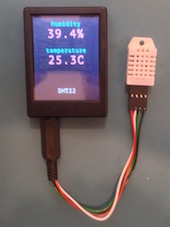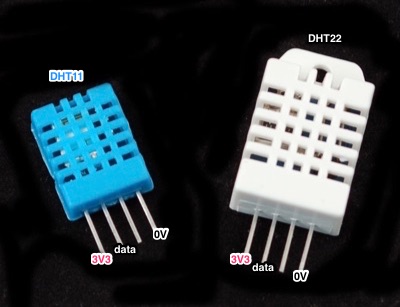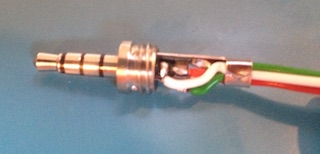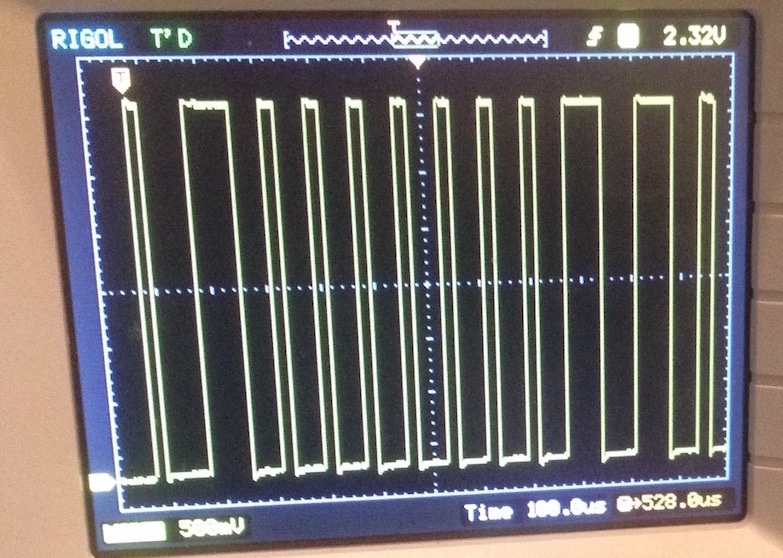1. Humidity harware setup¶
The purpose of this tutorial is to build a humidity app.

Sensor¶
To get humidity readings into my Mono, I will need a humidity sensor. For this app I will use the relatively low cost sensors DHT11 and DHT22. Their underlying hardware communication protocol is the same, but the interpretation of the readings differ slightly (DHT22 has better resolution).

Connecting the sensor to Mono¶
The sensor uses a single wire to transmit data, and it must get power through two additional wires (3.3V and 0V).
So I need three wires in total from Mono to the sensor. Mono’s mini-jack accomodates a total of four wires, so I will use a mini-jack connector and solder a set of wires to it. For this particular application, I could use a regular three-wire mini-jack, but the mini-jack connector I have has four connections, so I will solder all four wires and reserve the fourth wire for future experiments.

Here I have put a red wire on the tip, a white wire on ring 1 (the one next to the tip), a black wire on the sleeve. The green wire is connectred to ring 2, but it is not used in the app.
With that taken care of, I can connect the sensor to my Mono and start pulling out data from the sensor.
Data communication¶
To sanity check the connection, I will make the simplest possible app that can request a reading from the sensor, and then view the result on an oscilloscope. You do not need to do this, of course, but I will need to do that to show you what the sensor communication looks like.
An application to get the sensor talking must put 3.3V on the tip (red wire), and then alternate the data line (white wire) between 3.3V and 0V to tell the sensor that it needs a reading. The sleeve (black wire) is by default set to 0V, so nothing needs to be setup there.
More specificly, the data line must be configured to be an output pin with pullup. To request a reading from the sensor, the data line needs to be pulled down to 0V for 18ms, and then set back to 1. After that, the sensor will start talking.
The following program makes such a request every 3 seconds.
#include <mono.h>
#include <mbed.h>
class AppController
:
public mono::IApplication
{
mono::Timer measure;
mbed::Ticker ticker;
mono::io::DigitalOut out;
public:
AppController()
:
measure(3*1000),
out(J_RING1,1,PullUp),
{
measure.setCallback<AppController>(this,&AppController::requestSensorReading);
}
void monoWakeFromReset ()
{
put3V3onTip();
measure.Start();
}
void monoWillGotoSleep ()
{
turnOffTip();
}
void monoWakeFromSleep () {}
void put3V3onTip ()
{
DigitalOut(VAUX_EN,1);
DigitalOut(VAUX_SEL,1);
DigitalOut(JPO_nEN,0);
}
void turnOffTip ()
{
DigitalOut(JPO_nEN,1);
}
void requestSensorReading ()
{
out = 0;
ticker.attach_us(this,&AppController::IRQ_letGoOfWire,18*1000);
}
void IRQ_letGoOfWire ()
{
out = 1;
}
};
Side note: I use the IRQ_ prefix on functions that are invoked by interrupts to remind myself that such functions should not do any heavy lifting.
When I connect Mono to the sensor, and hook up an oscilloscope to the data and ground wires, then I get the following picture of the communication when I run the app.

To the left you can see a tiny bit of the end of the 18ms period, ending in a rising edge (the transition from 0V to 3.3V) marked by T (the trigger point). From there on, the sensor takes over and starts alternating the data line between 3.3V and 0V.
The first 3.3V period is just a handshake, and after that the length of each 3.3V period determines whether data sent from the sensor is a logical 1 or a logical 0. For the screenshot above, the visible part of data is 0000000110.
What exactly does that mean? Well, I will tell you in the next part.